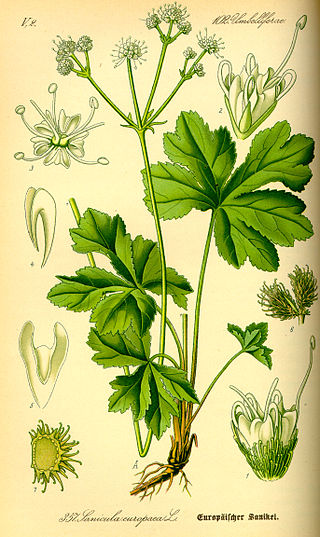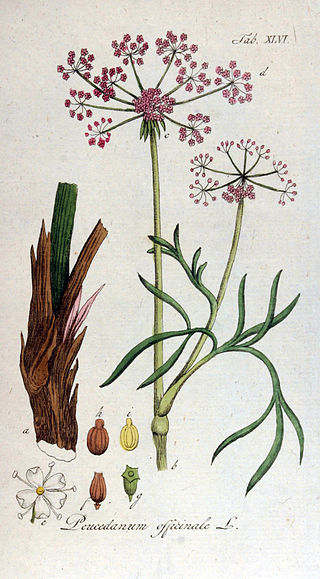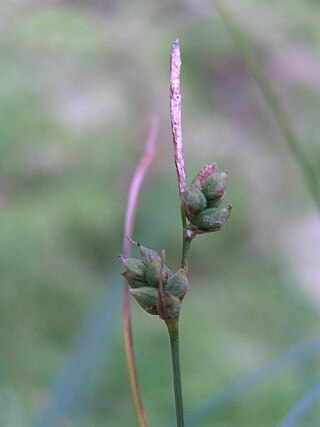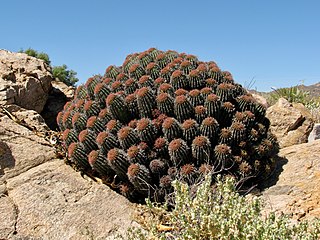Dioclea is a genus of flowering plants in the pea family, Fabaceae, that is native to the Americas. The seeds of these legumes are buoyant drift seeds, and are dispersed by rivers.

The Celastraceae are a family of 98 genera and 1,350 species of herbs, vines, shrubs and small trees, belonging to the order Celastrales. The great majority of the genera are tropical, with only Celastrus, Euonymus and Maytenus widespread in temperate climates, and Parnassia (bog-stars) found in alpine and arctic climates.

Loasaceae is a family of 15–20 genera and about 200–260 species of flowering plants in the order Cornales, native to the Americas and Africa. Members of the family include annual, biennial and perennial herbaceous plants, and a few shrubs and small trees. Members of the subfamily Loasoideae are known to exhibit rapid thigmonastic stamen movement when pollinators are present.

Sanicula is a genus of plants in family Apiaceae, the same family to which the carrot and parsnip belong. This genus has about 45 species worldwide, with at least 22 in North America. The common names usually include the terms sanicle or black snakeroot.

Ormosia is a genus of legumes. 131 living species, mostly trees or large shrubs, are native to the tropical Americas, from southwestern Mexico to Bolivia and southern Brazil, to southern, southeastern, and eastern Asia, and to New Guinea and Queensland. Most are tropical, while some extend into temperate temperate regions of China. A few species are threatened by habitat destruction, while the Hainan ormosia is probably extinct already.

Peucedanum is a genus of flowering plant in the carrot family, Apiaceae. Peucedanum boasts a global presence with diverse spread of morphological features. Peucedanum species are characterized by dorsally compressed mericarps, slightly prominent dorsal ribs, narrowly winged lateral ribs, and a broad commissure. However, the vast diversity of morphology, fruit forms, and phytochemical production makes classifying species in the Peucedanum challenging. Historically relevant in traditional medicine, Peucedanum's taxonomic complexity arises from its extensive diversity.

Carex globularis is a perennial species of sedge in the family Cyperaceae native to damp forests and wetlands of Asia, Eastern Europe, and Scandinavia.

Macropsychanthus is a genus of flowering plants in the legume family, Fabaceae. It belongs to the tribe Diocleae, subfamily Faboideae. The genus has 47 species with a pantropical distribution, ranging through the tropical Americas from southern Mexico to northeastern Argentina, west and central Africa, Madagascar, Indochina, Malesia, Papuasia, and Queensland.

Elytrophorus is a genus of Asian, African, and Australian plants in the grass family.

Elaeodendron is a genus of flowering plants in the staff vine family, Celastraceae. It includes 39 species native to the tropics of the Americas, sub-Saharan Africa, Asia, Australia, and the South Pacific.

Cassine is a genus of trees, of the plant family Celastraceae.
Ipomopsis globularis is a species of flowering plant in the phlox family known by the common name Hoosier Pass ipomopsis. It is endemic to Colorado in the United States, where it grows in the Rocky Mountains.

Euphorbia stellispina is a species of flowering plant in the family Euphorbiaceae endemic to southern Africa. It is locally known in Afrikaans as skaapnoors, sterretjie-noors, or Karoo noorsdoring. Euphorbia stellispina grows in rocky areas of karroid shrublands.
Trochantha is a genus of flowering plants belonging to the family Celastraceae.
Cyclorhiza is a genus of flowering plants belonging to the family Apiaceae.
Lauridia is a genus of flowering plants belonging to the family Celastraceae.

Pherosphaera is a genus of conifers belonging to the family Podocarpaceae.
Pristimera is a genus of flowering plants belonging to the family Celastraceae.
Pachypleurum is a genus of flowering plants belonging to the family Apiaceae.











